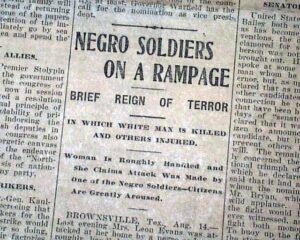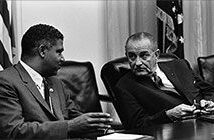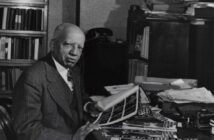
The Brownsville Affair, or the Brownsville Raid, was a racial incident that arose out of tensions between black soldiers and white citizens in Brownsville, Texas, in 1906. When a white bartender was killed and a police officer wounded by gunshot, townspeople accused the members of the 25th Infantry Regiment, a unit of Buffalo Soldiers stationed at nearby Fort Brown. Although commanders said the soldiers had been in the barracks all night, evidence was planted against them.
As a result of a United States Army Inspector General’s investigation, President Theodore Roosevelt ordered the dishonorable discharge of 167 soldiers of the 25th Infantry Regiment, costing them pensions and preventing them from serving in civil service jobs. A renewed investigation in the early 1970s exonerated the discharged black troops. The government pardoned them and restored their records to show honorable discharges but did not provide retroactive compensation.
Since arriving at Fort Brown on July 28, 1906, the black soldiers had been required to follow the legal color line mandate from white citizens of Brownsville, which included separate accommodation for black people and white people, showing respect for white people, and respect for local laws.
A reported attack on a white woman during the night of August 12 so incensed many townspeople that Maj. Charles W. Penrose, after consultation with Mayor Frederick Combe, declared an early curfew the following day to avoid trouble.
On the night of August 13, 1906, gunshots killed a white bartender and wounded a Hispanic police officer in the town. Immediately the residents of Brownsville cast the blame on the black soldiers of the 25th Infantry at Fort Brown. The soldiers of the 25th Infantry were accused of the shootings, but the all-white commanders at Fort Brown confirmed that all of the soldiers were in their barracks at the time of the shootings. Local whites, including Brownsville’s mayor, still claimed that some of the black soldiers participated in the shooting.
Local townspeople of Brownsville began providing evidence of the 25th Infantry’s part in the shooting by producing spent bullet cartridges from Army rifles which they said belonged to the 25th’s men. Despite the contradictory evidence that demonstrated the spent shells were planted in order to frame men of the 25th Infantry’s role in the shootings, investigators accepted the statements of the local whites and the Brownsville mayor.
When soldiers of the 25th Infantry were pressured to name who fired the shots, they insisted that they had no idea who had committed the crime. Captain Bill McDonald of the Texas Rangers investigated 12 enlisted men and tried to tie the case to them. The local county court did not return any indictments based on his investigation, but residents kept up complaints about the black soldiers of the 25th.
At the recommendation of the Army’s Inspector General, President Theodore Roosevelt ordered 167 of the black troops dishonorably discharged because of their “conspiracy of silence”. Though it has been repeatedly claimed that six of the troops were Medal of Honors winners, historian Frank N. Schubert has shown that none of them actually were. Fourteen of the men were later reinstated into the army. This dishonorable discharge prevented the 153 other men from ever working in a military or civil service capacity. Some of the black soldiers had been in the U.S. Army for over twenty years, while others were extremely close to retirement with pensions, which they lost.
The prominent educator and activist, Booker T. Washington, got involved and asked President Roosevelt to reconsider his decision in the affair. Roosevelt instead dismissed Washington’s plea and allowed his decision to stand.
Black people and many white people across the United States were outraged at the actions of President Roosevelt. The black community, which had previously supported the Republican president (in addition to their loyalty to the party of Abraham Lincoln, black people noted that Roosevelt had invited Booker T. Washington to a White House dinner, and had spoken out publicly against lynching), began to turn against him. The administration withheld news of the discharge of the soldiers until after the 1906 Congressional elections, so that the pro-Republican black vote would not be affected. The case became a political football, with William Howard Taft, positioning for the next candidacy for presidency, trying to avoid trouble.
Leaders of major black organizations, such as the Constitution League, the National Association of Colored Women, and the Niagara Movement tried to persuade the administration not to discharge the soldiers, but were unsuccessful. From 1907–1908, the US Senate Military Affairs Committee investigated the Brownsville Affair, and the majority in March 1908 reached the same conclusion as Roosevelt. Senator Joseph B. Foraker of Ohio had lobbied for the investigation and filed a minority report in support of the soldiers’ innocence. Another minority report by four Republicans concluded that the evidence was too inconclusive to support the discharges. In September 1908 W. E. B. Du Bois urged black people to register to vote and to remember their treatment by the Republican administration when it was time to vote for president.
Feelings across the nation remained high against the government actions, but with Taft succeeding Roosevelt as President and Foraker failing to win re-election, some of the political pressure declined.
On February 23, 1909 The Committee on Military Affairs recommended favorably on Bill S.5729 for correction of records and reenlistment of Officers and men of Companies B,C, and D of the 25th Infantry.
Senator Foraker had not been re-elected to his senate seat. He continued to work on Brownsville in his remaining time in office, guiding a resolution through Congress to establish a board of inquiry with the power to reinstate the soldiers. The bill, which the administration did not oppose, was less than Foraker wanted. He had hoped for a requirement that unless specific evidence was shown against a man, he would be allowed to re-enlist. The legislation passed both houses and was signed by Roosevelt on March 2, 1909.
On March 6, 1909, shortly after he left the Senate, Joseph Foraker was the guest of honor at a mass meeting at Washington’s Metropolitan African Methodist Episcopal Church. Though both whites and African Americans assembled to recognize the former senator, all the speakers were African Americans, save Foraker. Presented with a silver loving cup, he addressed the crowd,
” I have said that I do not believe that a man in that battalion had anything to do with the shooting up of “Brownsville,” but whether any one of them had, it was our duty to ourselves as a great, strong and powerful nation to give every man a hearing, to deal fairly and squarely with every man, to see to it that justice was done to him, that he should be heard.”
On April 7, 1909 under the provisions of the Act of March 30, 1909 a Military Court of Inquiry was sent up by Secretary of War Jacob M. Dickinson to report on the charges and recommend for reenlistment those who had been discharged under Special Order # 266 November 9. 1906. Of the 167 discharged men 76 were located as witnesses and 6 did not wish to appear.
The 1910 Court of Military Inquiry undertook an examination of the soldiers’ bids for re-enlistment, in view of the Senate committee’s reports, but its members interviewed only about one-half of the soldiers discharged. It accepted 14 for re-enlistment, and eleven re-entered the Army.
The government did not re-examine the case until the early 1970s.




